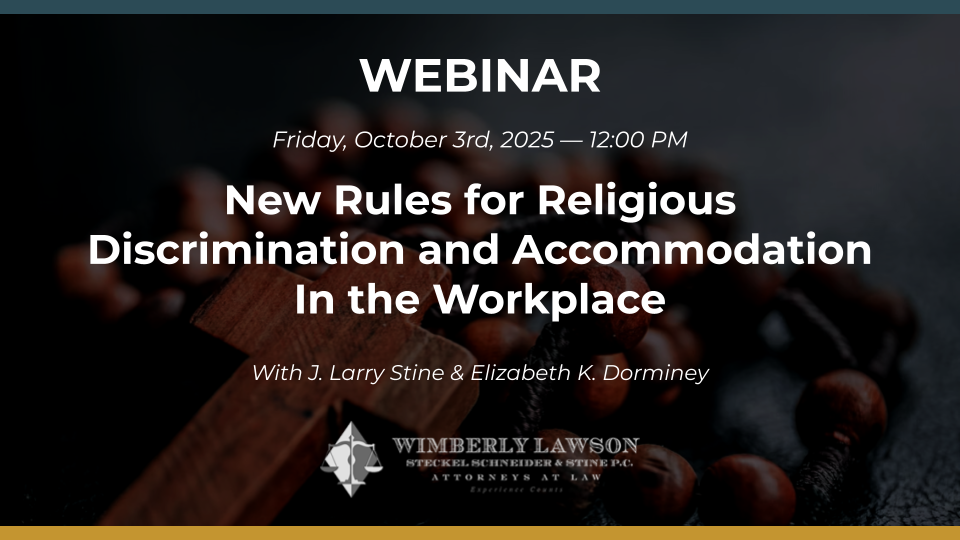EEO-1 PAY DATA DEADLINE LOOMS
In case you haven’t heard, September 30, 2019 is the deadline for employers with more than 100 employees to file a new electronic form with the Equal Employment Opportunity Commission (EEOC) disclosing detailed pay data for 2017 and 2018. EEOC has set up an electronic portal for these submissions, which must include detailed compensation data for 10 job categories, identifying employees by the same racial, ethnic and sex groupings used when submitting demographic data in earlier EEO-1 forms.
This comes amid ongoing litigation between an advocacy group and the EEOC, pursuant to an order from the D.C. District Court. (The case has been appealed, but not stayed, which means that employers are expected to comply even as the appeal is pending.) The push to collect pay data by demographic groupings, called “Component 2” of the EEO-1 form, originated in the Obama Administration: the Trump Administration put the Obama-era regulations on hold, but they was revived in a lawsuit, National Women’s Law Center, et al., v. Office of Management and Budget, et al. The Court has ordered the EEOC to ensure Component 2 compliance at levels at least as good as those for the regular EEO-1 submissions by the September 30 deadline. Interestingly, EEO-1 compliance levels run at about two-thirds of covered employers, and EEOC has always held the door open for filings for at least 11 months after the due date. As of September 5, EEOC reported that only 13.4% of covered employers had submitted the Component 2 information.
Employers are legitimately concerned about the confidentiality of sensitive compensation data and worry that their information will be harvested by private attorneys seeking to file pay discrimination lawsuits. We recommend that employers filing submissions use the “comment” box on the form to note that (1) the information provided is considered by the employer to be private, privileged and confidential, and is submitted subject to the EEOC’s assurance that it will not be disclosed; (2) the employer made its best efforts to gather information as required based upon dates set retroactively, and therefore the information provided is qualified due to various data-gathering issues; and (3) employees in the various pay “bands” do not perform equal work.
The required form is 15 pages long and must be submitted electronically. It’s not clear whether extensions will be granted, but some covered employers already have asked for hardship waivers. And it’s not clear what the penalty for noncompliance would be: there’s only one reported case of an employer being fined for failing to timely submit the regular EEO-1 form, and that fine was just $100.
EEOC has prepared detailed guidance on how to complete the form, which may be viewed at https://eeoccomp2.norc.org/info. The Commission also is offering answers to employers’ frequently asked questions at: https://eeoccomp2.norc.org/faq. A word of warning: after the electronic report is submitted, the employer will not be able to access it. If reports are due in future years, the employer will have to start from scratch. To avoid having to re-invent the wheel, a prudent employer will take care to create and retain backup copies of all documentation submitted.
If the National Women’s Law Center case is reversed by the D.C. Circuit, the Component 2 requirement will go away, and employers who fail to file on time presumably will be excused. But as of this writing, the court has ordered employers to file by September 30. Further, on September 11, 2019, the EEOC announced that the filing of Component 2 may be a one-time event, as the EEOC states the burden to collect the data is higher than previously estimated and deserves additional examination before the Agency seeks White House approval for more pay reporting. The previous pay collection requirement is set to expire after September 30, so there is additional temptation to employers to employers to file late or not at all. Stay tuned!
Related Content
Get Email Updates
Recent Content

New Rules for Religious Discrimination and Accommodation In the Workplace

TPS Update (as of 9/3/2025)

DOL To Shut Down OFCCP and Transfer Duties to EEOC

Meaning of Supreme Court Ruling Limiting Nationwide Injunctions in Birthright Case

In Spite of Adminstration Changes, Monitoring of the Workplace Continues to Create Legal Issues

